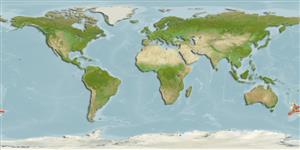Malacostraca |
Decapoda |
Nephropidae
Environment: milieu / climate zone / ระดับความลึก / distribution range
นิเวศวิทยา
; ระดับความลึก 140 - 640 m (อ้างอิง 4). Temperate; 6°C - 14°C (อ้างอิง 128678), preferred 14°C (อ้างอิง 107945); 33°S - 48°S, 166°E - 173°W (อ้างอิง 4)
Indo-west Pacific: New Zealand and Kermadec Island.
Length at first maturity / ขนาด / Weight / Age
วัยเจริญพันธุ์: Lm 3.4 range ? - ? cm Max length : 25.0 cm TL เพศผู้/กระเทย; (อ้างอิง 4); common length : 15.5 cm TL เพศผู้/กระเทย; (อ้างอิง 4)
It has a total body length of 25 cm, mostly between 13 and 18 cm (Ref. 4). Prefers mud or sandy mud substrates that are firm enough for burrowing (Refs. 4, 106910) (Ref. 4).
Members of the order Decapoda are mostly gonochoric. Mating behavior: Precopulatory courtship ritual is common (through olfactory and tactile cues); usually indirect sperm transfer.
Holthuis, L.B. 1991 FAO Species Catalogue. Vol. 13. Marine lobsters of the world. An annotated and illustrated catalogue of species of interest to fisheries known to date. FAO Fish. Synop. 125(13):292p. Rome: FAO. (อ้างอิง 4)
IUCN Red List Status
(อ้างอิง 130435: Version 2025-1)
CITES status (อ้างอิง 108899)
Not Evaluated
CMS (อ้างอิง 116361)
Not Evaluated
Threat to humans
Human uses
การประมง: การค้า
FAO - การประมง: landings | FishSource | ทะเลรอบๆเรา
เครื่องมือ
ข้อมูลเพิ่มเติม
นิเวศวิทยาเขตร้อนFood items (preys)
องค์ประอบของอาหาร
การบริโภคอาหาร
ผู้ล่า
Population dynamicsการเจริญเติบโตMax. ages / sizesLength-weight rel.Length-length rel.Length-frequenciesMass conversionอุดมสมบรูณ์ Human RelatedStamps, coins, misc.
แหล่งที่มาจากอินเตอร์เน็ต
Estimates based on models
Preferred temperature
(Ref.
115969): 8.6 - 13.4, mean 10.9 (based on 30 cells).
Fishing Vulnerability
Low vulnerability (15 of 100).
Climate Vulnerability
Moderate vulnerability (37 of 100).
Nutrients : Calcium = 109 [35, 184] mg/100g; Iron = 1.59 [1.21, 1.97] mg/100g; Protein = 20.2 [19.2, 21.3] %; Omega3 = 0.285 [0.185, 0.386] g/100g; Selenium = 48.3 [-31.7, 128.3] μg/100g; VitaminA = 0 μg/100g; Zinc = 1.79 [1.17, 2.40] mg/100g (wet weight); based on
nutrient studies.
